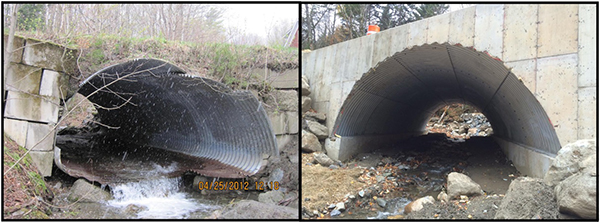A new larger and longer-lasting culvert allows Bradley Brook to pass more naturally under West Hill Road in Warren. The old culvert – a combination of corrugated metal pipe and concrete blocks – was rusting out, caving in and blocking aquatic wildlife movement. In its place is a larger metal arch culvert with an open, natural streambed bottom that allows normal stream shifts, encourages fish passage, avoids corrosion over time and greatly improves flood resilience.
Since Tropical Storm Irene, Friends of the Mad River has worked with municipal, private, state and federal partners to increase stream connectivity, improve wildlife habitat and build the community’s flood resilience by replacing impaired road-stream crossings. As part of this initiative, partners identified the West Hill Road/Bradley Brook crossing as problematic from both fish habitat and long-term maintenance perspectives.
PRIORITIES FOR REPLACEMENT
This culvert’s base had eroded so much that the stream dropped nearly a foot at its outlet and fully blocked trout movement upstream while the rusting pipe was soon to create maintenance troubles for the town. With these problems in mind and because re-establishing fish passage at this location would open over 3 miles of habitat upstream to native trout, this culvert rose to the top of Friends of the Mad River’s priorities for replacement.
“We have thousands of undersized culverts in Vermont resulting in ecological impacts and posing threats to public and private infrastructure,” said Rich Kirn, Vermont Department of Fish and Wildlife’s fisheries program manager. “Working in partnership has been a great approach to identify and prioritize stream-crossing enhancement projects to more effectively use limited natural resource funding.”
“A significant portion of the Mad River’s headwaters are within the Green Mountain National Forest lands, so we see the importance of reconnecting protected headwaters to the rest of the watershed network,” notes Dan McKinley, Green Mountain & Finger Lakes National Forest fisheries program manager. Jaime Masterson, U.S. Fish and Wildlife Service fish biologist adds, “Three miles of pristine headwater habitat is now accessible to brook trout, which is particularly important in the face of climate change because it offers the thermal refugia and spawning habitat native trout need to survive.”
COLLABORATIVE EFFORT
A yearlong effort – through planning, design, permitting and construction phases – culminated in late October when grass seed and straw went down across the disturbed ground. Corrie Miller, Friends of the Mad River’s executive director, called the project a “truly collaborative effort.”
“Shepherding a large project like this to completion is no easy feat and it takes the hard work and dedication of so many,” Miller said. The town of Warren, U.S. Fish and Wildlife Service, U.S. Forest Service, Vermont Community Foundation, Vermont Department of Fish and Wildlife, Winooski Natural Resources Conservation District and Friends of the Mad River brought together nearly $300,000 to replace this high-priority culvert, as well as hundreds of hours of partners’ collective time.
Milone and MacBroom in Waterbury engineered the state-of-the-art culvert while Dubois Construction in Middlesex built it. “We have a great team here in the Mad River Valley and this culvert is evidence of that,” said Miller. Andrew Cunningham, chair on behalf of the Warren Select Board, said, “Partnerships like this help Vermont towns solve 21st-century infrastructure woes and provide tremendous benefits to taxpayers and wildlife.”
WHY CULVERTS MATTER
“Most people drive over dozens of culverts each day but barely even notice them until there’s a problem. The Mad River Valley’s road network lies atop the surface water network and the two intersect. At these road-stream intersections, streams are routed under bridges and through culverts, many of which are significantly narrower than the stream’s width at normal flow. Rain or melt events bring on the problems for these too-small culverts: debris blockages cause flooding of the road and adjacent private property; water speeds up through the culverts and its force erodes streambanks downstream; and scouring water can undermine structures and create large drop-offs at the culvert outlet that block fish from accessing upstream habitat. In any case, no one wins. However, appropriately sized, open-bottom culverts move water and debris as if there is no problematic intersection, thereby reducing the negative impacts of our road network on our streams and reducing damage from our streams on our roads. And then, everyone wins,” Miller explained.
For more information about Mad River Valley efforts to build flood resilience and aquatic organism passage, contact Friends of the Mad River. Friends of the Mad River is a community-supported organization dedicated to conserving the ecological, recreational and community values of the Mad River and its 144-square-mile watershed.






